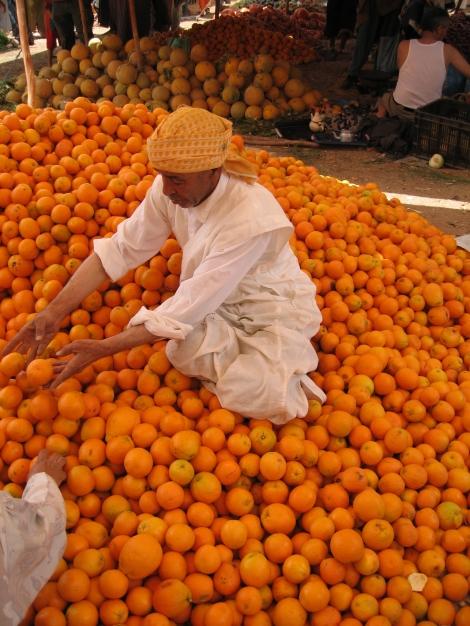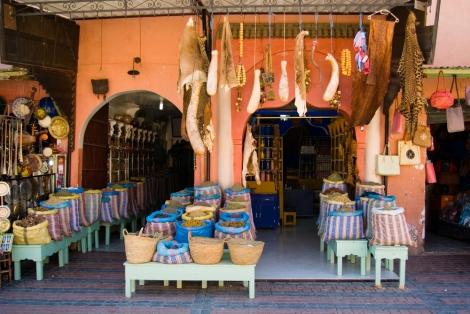
The souks, or market places, in Moroccan cities often take up entire city blocks and are made up of stall after stall of goods that wind their way through the narrow alleys and side streets, often only wide enough for pedestrians and the occasional donkey. The stalls themselves are piled high with Moroccan goods from traditional brightly colored carpets and scarves, sacks of exotic herbs and spices, to freshly picked fruits and slaughtered meat from local farmers.
As well as a place for Moroccans to buy and sell their goods, souks are also important parts of the social scene within Moroccan culture, serving as a place to settle disputes and debts and also as a place where families can meet to discuss future wedding plans. As women customarily stayed home and kept out of the public eye in rural Morocco the weekly souks offered a chance for women from different families to meet, gather cooking materials for upcoming meals, and catch up on the latest gossip.

The souks may seem chaotic crazy to an outsider but there is actually an organization to them that helps make the souks easier to navigate. Specialty souks within the souk itself specialize in one product such as Moroccan scarves, setting it apart from the next street over which might be the meat souk. This means shoppers can browse through the colorful stalls filled with silk scarves along one street to inspect the quality and compare the prices between stalls before moving on to the next street and selecting the cut of lamb they wish to purchase for dinner that night.
Haggling
Haggling is an expected part of the buying and selling process in Moroccan souks. It is not unusual for a shopper wishing to buy a high quality Moroccan rug to spend half the day bargaining with the rug seller over the price, often over many cups of sweet mint tea. The process usually begins with the shop keeper naming a price and then the buyer will then counter that offer usually with a number 1/3 to ½ the amount the shop keeper suggested. The buyer and seller will then go back and forth offering and counter offering before finally agreeing on a price. Patience and respect are important in the bargaining process and if a shop keeper allows you to walk away without purchasing his product then you underestimated its value and offered too low a price.

Two of the most impressive souks occur in the cities of Fes and Marrakech. In Marrakech the souk is located behind the famous Djemma el Fna square where street performers, snake charmers, and story tellers gather along with food and orange juice vendors to provide entertainment and refreshment. The souk itself is spread out along the twisty side streets behind the square and offers shoppers a wide and varied choice of traditional Moroccan goods.

While Marrakech is famous of its circus-like main square the souk in Fes is more of a practical nature where locals go to buy day to day produce as well as specialty items. Fes is famous for its extensive tanneries which are one of the most photographed sites in Africa making the souks in Fes the best places to buy leather products.
These daily souks have changed little over the centuries and for visitors who wish to truly experience Moroccan culture the best way is to step into the hustling and chaotic world of the Moroccan souk. For the large crowded souks of Fes and Marrakech it is often suggested that tourists hire a guide to help them find their way and assist them in haggling over prices with shop keepers.
The most important thing to remember in a Moroccan souk is to have fun! Enjoy browsing through the items and haggling with the shop keeper, it is a unique Moroccan experience that is sure to provide plenty of stories and one of a kind souvenirs to take back home.


